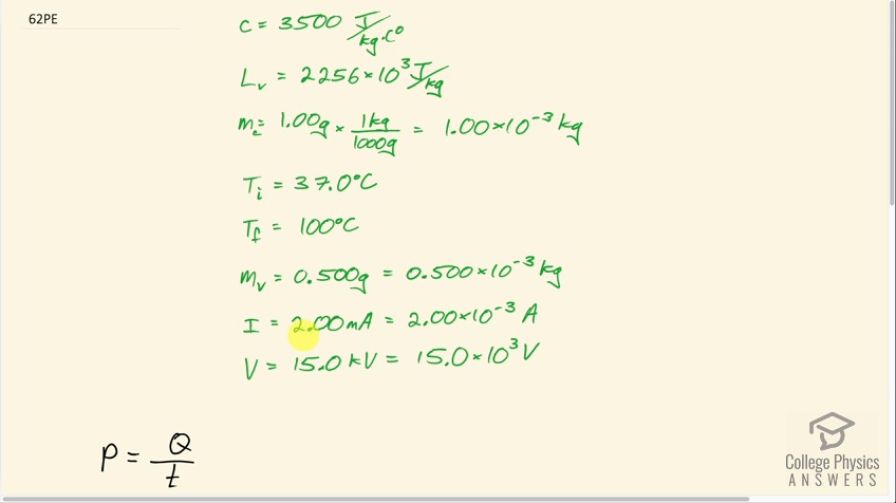Question
How much time is needed for a surgical cauterizer to raise the temperature of 1.00 g of tissue from to and then boil away 0.500 g of water, if it puts out 2.00 mA at 15.0 kV? Ignore heat transfer to the surroundings.
Final Answer
Solution video
OpenStax College Physics for AP® Courses, Chapter 20, Problem 62 (Problems & Exercises)

vote with a rating of
votes with an average rating of
.
Calculator Screenshots
Video Transcript
This is College Physics Answers with Shaun Dychko. A surgical cauterization tool is used to stop bleeding and it has a current of 2.00 milliamps going through it, which is 2.00 times 10 to the minus 3 amps and a voltage of 15.0 kilovolts, which is 15.0 times 10 to the 3 volts. It's going to be heating 1.00 gram of tissue which is 1.00 times 10 to the minus 3 kilograms because there are 1 kilogram for every 1000 grams and the tissue begins at a temperature of 37.0 degrees Celsius— which is body temperature— and goes to a final temperature of 100 degrees Celsius and then the water within that tissue vaporizes and so we need to know the latent heat of vaporization for water or human tissue which we... it actually says it's water is what's vaporizing. So latent heat of vaporization for water is 2256 times 10 to the 3 joules per kilogram but only 0.500 grams of water is vaporized so we convert that into kilograms. And the specific heat of human tissue is 3500 joules per kilogram per Celsius degree and we looked all this stuff up in tables [14.1] so the human body has specific heat of 3500 joules per kilogram per Celsius degree and water has a latent heat of vaporization of 2256 times 10 to the 3 joules per kilogram. Okay! So that's all we need to know to answer this question so the hardest part of the question was just collecting data from different places. So how long does it take for this cauterization tool to do the job? So the power output of the cauterization tool is the amount of energy it outputs, which is in the form of heat so I am using the letter Q here because that's the letter that we used for heat energy in chapter 14 and the rate at which it's producing heat is the power so that's Q divided by t in other words. So we can solve for t by multiplying both sides by t over P and so we have t then is the heat divided by the power. Now the power is provided by this current at this voltage and we can substitute P then with IV— current times voltage. The Q is gonna be replaced with this this is the amount of heat absorbed to raise the temperature of the 1.00 gram of tissue and I have a subscript c here to indicate that his mass is different from this mass here because the mass that's being vaporized is just the half gram of water whereas the mass that's having its temperature increased is the total mass of the tissue— I put a little letter c there to say that it's corresponding to the specific heat, c. So this is 1.00 gram and this is 0.500 gram. So we have the term for amount of heat needed to vaporize and this is the term for the amount of heat needed to raise the temperature to the boiling point so we replace Q with all of this here. So the time then is 1.00 times 10 to the minus 3 kilograms of tissue that's going to have its temperature raised to a final temperature of 100 degrees Celsius and from that we subtract 37.0 degrees Celsius—initial temperature— and multiply this by the specific heat of human tissue and add to that the 0.500 times 10 to the minus 3 kilograms of water that will be vaporized multiplied by the latent heat of vaporization and divide by the current—2.00 milliamps— times the voltage of 15.0 kilovolts and we get 45.0 seconds will be the time it takes to do this cauterization.
